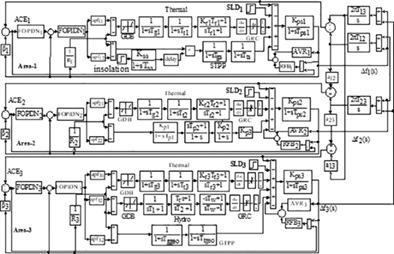当前位置:
X-MOL 学术
›
Int. Trans. Electr. Energy Syst.
›
论文详情
Our official English website, www.x-mol.net, welcomes your
feedback! (Note: you will need to create a separate account there.)
Performance of redox flow battery in combined frequency and voltage control of multi‐area multi‐source system using CFOPDN‐FOPIDN controller
International Transactions on Electrical Energy Systems ( IF 1.9 ) Pub Date : 2021-01-04 , DOI: 10.1002/2050-7038.12782 Biswanath Dekaraja 1 , Lalit C. Saikia 1
International Transactions on Electrical Energy Systems ( IF 1.9 ) Pub Date : 2021-01-04 , DOI: 10.1002/2050-7038.12782 Biswanath Dekaraja 1 , Lalit C. Saikia 1
Affiliation

|
This paper presents the combined voltage and frequency control of three‐area multi‐source interconnected power systems, having thermal‐solar thermal power plant, thermal‐wind and hydrothermal‐geothermal power plants. A maiden attempt has been made to incorporate one of the energy storage devices called redox flow battery (RFB) in all areas. Appropriate system non‐linearity constraints are considered for both thermal and hydro plants. A new cascade controller called cascade fractional‐order PD with filter and fractional‐order proportional‐integral‐derivative (PID) with filter (CFOPDN‐FOPIDN) is proposed as a secondary controller in the unified automatic load frequency control (ALFC) and automatic voltage regulator (AVR) system. A novel optimization algorithm called artificial flora algorithm is used to optimize the controller parameters. From the observation of the system dynamic responses, it reveals that the CFOPDN‐FOPIDN controller is superior to the FOPID, PIDN and PI controllers. The unified ALFC‐AVR study exhibits that the AVR loop enhances the system dynamics considerably. It is observed that the system oscillations are substantially reduced along with the peak deviation and settling time in the presence of RFB. Moreover, the combined frequency deviation and area control error as an input signal to the RFB outperforms the individual one. The system performance improves with an increase in the RFB gain value. Furthermore, it is divulged that a larger frequency deviation leads to a faster rate of change of frequency. Eventually, the sensitivity analysis reveals the sturdiness of the proposed controller.
中文翻译:

使用CFOPDN-FOPIDN控制器在多区域多源系统的频率和电压组合控制中氧化还原液流电池的性能
本文介绍了三区域多源互联电力系统的电压和频率组合控制,包括热电热电厂,热风和水热地热电厂。已经进行了首次尝试,在所有区域中都集成了一种被称为氧化还原液流电池(RFB)的储能设备。对于火力发电厂和水力发电厂,都应考虑适当的系统非线性约束。提出了一种新的级联控制器,称为带滤波器的级联分数阶PD和带滤波器的分数阶比例积分微分(PID)(CFOPDN-FOPIDN),作为统一的自动负载频率控制(ALFC)和自动电压的次级控制器调节器(AVR)系统。一种称为人工菌群算法的新型优化算法用于优化控制器参数。从对系统动态响应的观察中可以看出,CFOPDN-FOPIDN控制器优于FOPID,PIDN和PI控制器。统一的ALFC-AVR研究表明,AVR回路大大提高了系统动态性。可以看出,在存在RFB的情况下,系统振荡以及峰值偏差和建立时间都大大降低了。而且,组合的频率偏差和区域控制误差作为RFB的输入信号要优于单个信号。随着RFB增益值的增加,系统性能也会提高。此外,令人不安的是,较大的频率偏差导致更快的频率变化率。最终,灵敏度分析揭示了所提出控制器的坚固性。它表明CFOPDN-FOPIDN控制器优于FOPID,PIDN和PI控制器。统一的ALFC-AVR研究表明,AVR回路大大提高了系统动态性。可以看出,在存在RFB的情况下,系统振荡以及峰值偏差和建立时间都大大降低了。而且,组合的频率偏差和区域控制误差作为RFB的输入信号要优于单个信号。随着RFB增益值的增加,系统性能也会提高。此外,令人不安的是,较大的频率偏差导致更快的频率变化率。最终,灵敏度分析揭示了所提出控制器的坚固性。它表明CFOPDN-FOPIDN控制器优于FOPID,PIDN和PI控制器。统一的ALFC-AVR研究表明,AVR回路大大提高了系统动态性。可以看出,在存在RFB的情况下,系统振荡以及峰值偏差和建立时间都大大降低了。而且,组合的频率偏差和区域控制误差作为RFB的输入信号要优于单个信号。随着RFB增益值的增加,系统性能也会提高。此外,令人不解的是,较大的频率偏差会导致更快的频率变化率。最终,灵敏度分析揭示了所提出控制器的坚固性。统一的ALFC-AVR研究表明,AVR回路大大提高了系统动态性。可以看出,在存在RFB的情况下,系统振荡以及峰值偏差和建立时间都大大降低了。此外,组合的频率偏差和区域控制误差作为RFB的输入信号,其性能优于单个RFB。随着RFB增益值的增加,系统性能也会提高。此外,令人不安的是,较大的频率偏差导致更快的频率变化率。最终,灵敏度分析揭示了所提出控制器的坚固性。统一的ALFC-AVR研究表明,AVR回路大大提高了系统动态性。可以看出,在存在RFB的情况下,系统振荡以及峰值偏差和建立时间都大大降低了。而且,组合的频率偏差和区域控制误差作为RFB的输入信号要优于单个信号。随着RFB增益值的增加,系统性能也会提高。此外,令人不安的是,较大的频率偏差导致更快的频率变化率。最终,灵敏度分析揭示了所提出控制器的坚固性。作为RFB的输入信号,组合的频率偏差和区域控制误差的性能优于单个RFB。随着RFB增益值的增加,系统性能也会提高。此外,令人不安的是,较大的频率偏差导致更快的频率变化率。最终,灵敏度分析揭示了所提出控制器的坚固性。作为RFB的输入信号,组合的频率偏差和区域控制误差的性能优于单个RFB。随着RFB增益值的增加,系统性能也会提高。此外,令人不安的是,较大的频率偏差导致更快的频率变化率。最终,灵敏度分析揭示了所提出控制器的坚固性。
更新日期:2021-03-02
中文翻译:

使用CFOPDN-FOPIDN控制器在多区域多源系统的频率和电压组合控制中氧化还原液流电池的性能
本文介绍了三区域多源互联电力系统的电压和频率组合控制,包括热电热电厂,热风和水热地热电厂。已经进行了首次尝试,在所有区域中都集成了一种被称为氧化还原液流电池(RFB)的储能设备。对于火力发电厂和水力发电厂,都应考虑适当的系统非线性约束。提出了一种新的级联控制器,称为带滤波器的级联分数阶PD和带滤波器的分数阶比例积分微分(PID)(CFOPDN-FOPIDN),作为统一的自动负载频率控制(ALFC)和自动电压的次级控制器调节器(AVR)系统。一种称为人工菌群算法的新型优化算法用于优化控制器参数。从对系统动态响应的观察中可以看出,CFOPDN-FOPIDN控制器优于FOPID,PIDN和PI控制器。统一的ALFC-AVR研究表明,AVR回路大大提高了系统动态性。可以看出,在存在RFB的情况下,系统振荡以及峰值偏差和建立时间都大大降低了。而且,组合的频率偏差和区域控制误差作为RFB的输入信号要优于单个信号。随着RFB增益值的增加,系统性能也会提高。此外,令人不安的是,较大的频率偏差导致更快的频率变化率。最终,灵敏度分析揭示了所提出控制器的坚固性。它表明CFOPDN-FOPIDN控制器优于FOPID,PIDN和PI控制器。统一的ALFC-AVR研究表明,AVR回路大大提高了系统动态性。可以看出,在存在RFB的情况下,系统振荡以及峰值偏差和建立时间都大大降低了。而且,组合的频率偏差和区域控制误差作为RFB的输入信号要优于单个信号。随着RFB增益值的增加,系统性能也会提高。此外,令人不安的是,较大的频率偏差导致更快的频率变化率。最终,灵敏度分析揭示了所提出控制器的坚固性。它表明CFOPDN-FOPIDN控制器优于FOPID,PIDN和PI控制器。统一的ALFC-AVR研究表明,AVR回路大大提高了系统动态性。可以看出,在存在RFB的情况下,系统振荡以及峰值偏差和建立时间都大大降低了。而且,组合的频率偏差和区域控制误差作为RFB的输入信号要优于单个信号。随着RFB增益值的增加,系统性能也会提高。此外,令人不解的是,较大的频率偏差会导致更快的频率变化率。最终,灵敏度分析揭示了所提出控制器的坚固性。统一的ALFC-AVR研究表明,AVR回路大大提高了系统动态性。可以看出,在存在RFB的情况下,系统振荡以及峰值偏差和建立时间都大大降低了。此外,组合的频率偏差和区域控制误差作为RFB的输入信号,其性能优于单个RFB。随着RFB增益值的增加,系统性能也会提高。此外,令人不安的是,较大的频率偏差导致更快的频率变化率。最终,灵敏度分析揭示了所提出控制器的坚固性。统一的ALFC-AVR研究表明,AVR回路大大提高了系统动态性。可以看出,在存在RFB的情况下,系统振荡以及峰值偏差和建立时间都大大降低了。而且,组合的频率偏差和区域控制误差作为RFB的输入信号要优于单个信号。随着RFB增益值的增加,系统性能也会提高。此外,令人不安的是,较大的频率偏差导致更快的频率变化率。最终,灵敏度分析揭示了所提出控制器的坚固性。作为RFB的输入信号,组合的频率偏差和区域控制误差的性能优于单个RFB。随着RFB增益值的增加,系统性能也会提高。此外,令人不安的是,较大的频率偏差导致更快的频率变化率。最终,灵敏度分析揭示了所提出控制器的坚固性。作为RFB的输入信号,组合的频率偏差和区域控制误差的性能优于单个RFB。随着RFB增益值的增加,系统性能也会提高。此外,令人不安的是,较大的频率偏差导致更快的频率变化率。最终,灵敏度分析揭示了所提出控制器的坚固性。











































 京公网安备 11010802027423号
京公网安备 11010802027423号